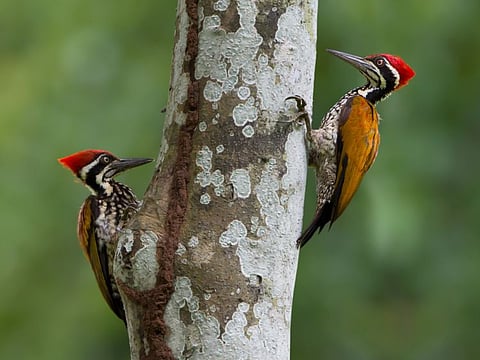Why every garden needs a woodpecker
Urban forests provide an interface between us and the birds

I grew up in a part of the world where there was a beautiful green-plumed woodpecker, but the only place to find it was on the label of a brand of hard cider. You would have to venture deep into some old-growth forest to encounter the living article. Perhaps Robin Hood had one as a pet.
When I came to Washington, I noticed woodpeckers seemed to be as common as pigeons. Well, not quite that common, but they were reliable visitors to trees in your garden and local park. And they flitted about in various shapes and sizes.
One challenge was to discern the hairy woodpecker from its doppelganger, the downy woodpecker. In addition to the hairy and downy woodpeckers, there are bigger and brighter woodpeckers happy to entertain the gardener and other nature lovers.
The red-bellied woodpecker has a creamy-tan coloured body with black and white barred wings, and its head is crowned with scarlet plumage, more on the male than the female. The northern flicker is bigger and so nattily attired that it alone justifies the purchase of a pair of binoculars. This species eats ants, hence its tendency to feed on the ground rather than scamper around trunks.
The prettiest species — and probably the one you are least likely to see — is the red-headed woodpecker. When I saw one, I thought I had been transported to the tropics. It is a compact, but not small, bird, with a white body, inky blue wings splashed white and a head that is entirely scarletAdrian Higgins
Then there is the pileated woodpecker, big as an owl and raven black, except for its white wing bars and the scarlet and white head markings. It is so bold and beautiful — like some modern day pterodactyl — that you feel you deserve only to glimpse it once or twice in your life. But it is common in any wooded area in the East and even in leafy gardens, where it will show up at the bird feeder.
In any of these species, I find that familiarity does not breed contempt.
I put this down to three factors: the extraordinary colours and patterns of their plumage; their agility on and around trees; and their capacity to turn their beaks, skulls and necks into rapid-fire chisels. In the natural world’s symphony orchestra, woodpeckers are the percussionists.
It is Washington’s urban forest that provides this interface between us and the woodpecker. Apart from the abundance of species, we see woodpeckers frequently because much of the tree canopy has dead trees or branches, and it is in deadwood that woodpeckers excavate a hole to nest.
European cities tend to be less sylvan and the trees more manicured. The cavities that woodpeckers create and later abandon provide living space for other creatures — birds such as titmice, nuthatches and wrens, but also for flying squirrels.
Woodpeckers will sometimes alight on your house and start their rat-a-tat-tat heading. This worries people who think the bird is doing serious damage to the home or has found an abode riddled with insects. It is best to adopt a more relaxed attitude about animals around the home. I think a skink (a lizard) would be fine wandering into the kitchen, for example, but not a skunk.
The prettiest species — and probably the one you are least likely to see — is the red-headed woodpecker. When I saw one, I thought I had been transported to the tropics. It is a compact, but not small, bird, with a white body, inky blue wings splashed white and a head that is entirely scarlet.
You find nesting pairs in open woodlands, pine savannahs and stands of dead trees — snags — in swampland. It was in the last habitat that I found a small colony of them a few years ago, about midway along the Indian Head Rail Trail in Charles County, Md. I was on a bicycle at the time, but I returned last week on foot.
It took me about an hour to reach the spot, and, along the way, I came across a world a little removed from the downtown garden experience, including trailside areas full of sweet gum seedlings, wild carrot and jewelweed.
On the way back, I found another collection of snags, again with woodpecker holes but no birds. A dark, chirpy songbird perched high on one of them, and when I raised the binoculars, it revealed itself as an indigo bunting. This consoled the failed quest for the red-headed woodpecker. Just a little.
— Washington Post
Adrian Higgins is a gardening columnist.
Also Read: Off the cuff: Connecting at the dinner table
Sign up for the Daily Briefing
Get the latest news and updates straight to your inbox



